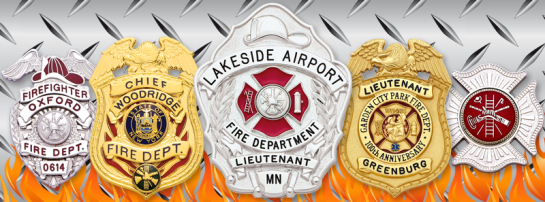
In the United States, professional and volunteer firefighters have a long history of heroism. Early organized fire fighting systems can be traced back to colonial days. What began as a loose community-based organization in the 1600’s evolved into an organized system of volunteers in the late 1700’s and early 1800’s. The first fully-paid department was established in 1853 in Columbus, Ohio.
Appropriately nicknamed “bravest”, these men and women put their lives on the line to respond to millions of calls each year. The Bravest wear badges adorned with symbolism of the history of the firefighter role. Common symbols are:
- Maltese Cross. The 8-point Maltese Cross originated during the Crusades. The Knights of St. John were fighting for possession of the holy land. During an epic battle of that fight, located on the island of Malta, fire was used as a new weapon of war against the Knights. In response, the knights banded together to fight the flames and rescue injured brothers from a fiery death. Later, these heroic fighters were awarded a badge of honor similar to the maltese cross. It has come to symbolize the protection provided by the wearer of the cross and the loyalty with which they serve.
- Scramble. The center seal of the firefighter badge typically depicts a grouping of fire symbols. The elements of the scramble can vary from department to department. Typically scrambles contain a ladder and an axe. Some contain more modern tools of the trade, such as a helmet or a fire hydrant. Others contain some more traditional tools such as a pike pole. As a group, the elements of the scramble symbolize preparedness.
- Bugles. In the early days of American firefighting, prior to wireless radios, orders were given at a fire scene using a brass megaphone known as a bugle. The person holding the bugle (and therefore giving the orders) was easily identified as the leader. Today the bugle is a symbol of leadership in fire department insignia, with an increasing number of bugles typically signifying more seniority (lieutenant, chief, etc.).
- The Color Red. Many fire badges contain red in the scramble or in the maltese cross. The origins of it’s use are twofold. First, the color red is most commonly associated with flames. Second, fire trucks and engines have historically been red for visibility purposes. Although modern science suggests other colors (such as lime green) may be more visible, many departments continue to drive red trucks. Regardless of the color of the trucks, badges containing red elements stand out visually and draw attention to the wearer.
The badges worn by our Bravest contain many symbolic elements. Below are some images of unique Firefighter badge styles, as well as a new fire badge style, inspired by the traditional leather helmet shield. We have many traditional and unique fire badges to choose from in addition to our full line of customizable badges.
Originally published by Smith & Warren
